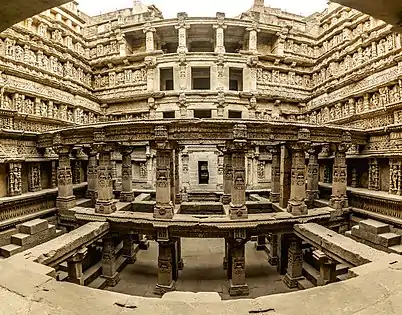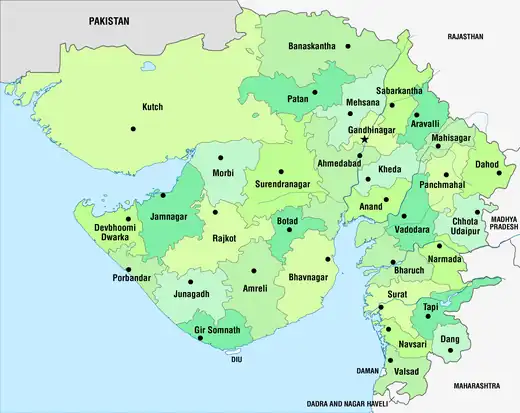The Architecture of Gujarat consists of architecture in the Indian state of Gujarat.
The first major civilization in Gujarat was the Harappan Civilization. Their settlements, including Dholvaira and Lothal are characteristic of Harappan architecture.
Islamic architecture flourished during the rule of the Gujarat Sultanate and Mughal Empire in Gujarat. Buildings were built in European styles, including Gothic and Neoclassical during the British Colonial period. Indo-Saracenic architecture also developed during this period. After independence in 1947, modernist architecture is seen in Gujarat.
Ancient period
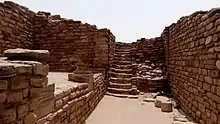
Indus Valley Civilization
Gujarat has a large number of archaeological sites associated with the Indus Valley civilization. The Indus Valley sites in Gujarat include Dholvaira, and Lothal architecture.
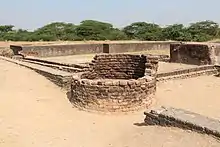
The city of Dholavira has a rectangular shape and organization. Unlike Harappa and Mohenjo-daro, the city was constructed to a pre-existing geometrical plan consisting of three divisions – the citadel, the middle town, and the lower town. The acropolis and the middle town had been furnished with their own defence-work, gateways, built-up areas, street system, wells, and large open spaces.
Early Nagara architecture (5th to 10th century)

The extant temples Early Nagara architecture include the Roda Group of Temples, Lakodra in Vijapur Taluka, old temple at Thangadh, Ranakdevi's Temple at Wadhwan, the Sun Temple at Kanthkot, Shiva temple at Puaranogadh at Manjal in Kutch. Harishchandra-ni-Chori at Shamlaji, older Bhadreshwar Jain Temple (rebuilt now) and the Temple III of Roda Group of Temples are some other extant temples of the 9th century.[1]
Saurashtra architecture (5th to 10th century)

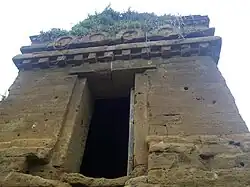 Firangi Deval at Kalsar
Firangi Deval at Kalsar%252C_From_East.jpg.webp) Magderu, Dhrasanvel, Okhamandal
Magderu, Dhrasanvel, Okhamandal Ruined temples at Sonkansari, Ghumli
Ruined temples at Sonkansari, Ghumli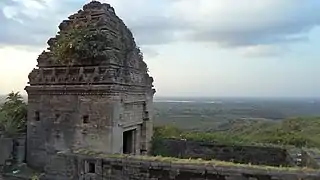 Temple at Sonkansari, Ghumli
Temple at Sonkansari, Ghumli
The Saurashtra architecture is in continuum of earlier Gupta period architecture found in caves at Uparkot and Khambhalida. More than hundred temples of Maitraka period is known. Almost all of them are located along the coastal belt of the western Saurashtra region except the one at Kalsar and few temples in the Barda hills region. Several temples of them are located in the territories controlled by the Saindhavas.[2]
The extant temples of this period are the temple at Gop, Sonkansari (Ghumli), Pachtar, Prachi, Firangi Deval at Kalsar, group of temples at Vasai near Dwarka, Kadvar, Bileshwar, Sutrapada, Visavada, Kinderkheda, Pata, Miyani, Pindara, Khimrana, two temples at Dhrasanvel (Magderu and Kalika Temple), two temples near Dhrewad (Kalika Mata Temple), Gayatri temple and Naga temple and Sun temple at Pasnavada, early temples at Junagadh, Gosa, Boricha, Prabhas Patan, Savri, Navadra, Suvarnatirth temple at Dwarka, Jhamra, Degam near Porbandar, Sarma near Ghed. Other extant temples include the temple groups at Khimeshwara, Shrinagar, Nandeshwara, Balej, Bhansara, Odadar; and the shrines at Bokhira, Chhaya, Visavada, Kuchadi, Ranavav, Tukada, Akhodar, Kalavad, Bhanvad, Pasthar, and Porbandar.[3]
Two kunds are known of this period, at Kadvar and Bhansara. The Shaivaite monastery at the Khimeshwara group of temples is the oldest known Brahminical monastery of India, preceding three centuries to that in central India.[3]
These temples are austere in their design and simple in decoration. They are important in architectural study to know the origin of Nagara-style shikhara and the beginning of their complex designs in temple architecture. These temples also point to the second of the two early Gujarat temple architecture schools; the north Gujarat early Nagara style and the Saurashtra style which initially influenced and ultimately ousted by the evolving Nagara style. The Saurashtra style disappeared by the tenth century.[4]
Māru-Gurjara architecture (11th to 13th CE)
Māru-Gurjara architecture, Chaulukya style or Solaṅkī style, is a style of north Indian temple architecture that originated in Gujarat and Rajasthan from the 11th to 13th centuries, under the Chaulukya dynasty (or Solaṅkī dynasty). On the exteriors, the style is distinguished from other north Indian temple styles of the period in "that the external walls of the temples have been structured by increasing numbers of projections and recesses, accommodating sharply carved statues in niches. These are normally positioned in superimposed registers, above the lower bands of moldings. The latter display continuous lines of horse riders, elephants, and kīrttimukhas. Hardly any segment of the surface is left unadorned." The main shikhara tower usually has many urushringa subsidiary spirelets on it, and two smaller side-entrances with porches are common in larger temples.
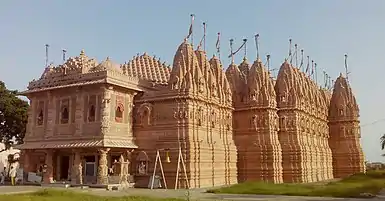
Examples of Chaulukya or Māru-Gurjara architecture include Taranga Jain temple, Rudra Mahalaya Temple, and Modhera Sun Temple. The Rani ki vav was also built during this period.
Indo-Islamic architecture
The first Muslim dynasty to rule large parts of Gujarat was the Delhi Sultanate in the 14th century. Gujarat would later be ruled by the Mughal empire, Gujarat Sultanate, and several Muslim-ruled princely states until 1947. Thus, Indo-Islamic architecture is found all over the state.
The Indo-Islamic architecture style of Gujarat drew micro-architectural elements from earlier Maru-Gurjara architecture and employed them in mihrab, roofs, doors, minarets and facades.[6] In the 15th century, the Indo-Islamic style of Gujarat is especially notable for its inventive and elegant use of minarets. They are often in pairs flanking the main entrance, mostly rather thin and with elaborate carving at least at the lower levels. Some designs push out balconies at intervals up the shaft; the most extreme version of this was in the lost upper parts of the so-called "shaking minarets" at the Jama Mosque, Ahmedabad,[7] which fell down in an earthquake in 1819. This carving draws on the traditional skills of local stone-carvers, previously exercised on Hindu temples in the Māru-Gurjara and other local styles.[8]
Delhi Sultanate
The construction during the rule of Delhi Sultanate in Gujarat continued earlier local architecture tradition which has reached in its pinnacle as Maru-Gurjara Architecture. The tradition continued in temples, mosques, residents and civic structures. The local tradition was modified and expanded to suit Islamic believes, rituals and practices. The construction of Islamic ritual buildings such as mosques were codified and standardised. Such codification is found in 15th century Sanskrit treatise, Rahmana-Prasada. One such early example of mosque include the Jami Mosque in Mangrol built in 1383-84.[9]
The notable mosques built during this period include Mosque of Al-Iraji at Junagadh (1286–87), Rahimat Mosque in Mangrol (1382-1383), Jami Mosque of Bharuch (1321), Jami mosque of Khambhat, Bahlol Khan Gazi or Hilal Khan Kazi Mosque (1333) and Tanka Mosque (1361) in Dholka. The tomb of Al-Khazeruni in Khambhat was built in 1333.[10]
Gujarat Sultanate
Under the Gujarat Sultanate, independent between 1407 and 1543, Gujarat was a prosperous regional sultanate under the rule of the Muzaffarid dynasty, who built lavishly, particularly in the capital, Ahmedabad, in its distinctive style of Indo-Islamic architecture.[11] The sultanate commissioned mosques such as the Jami Masjid of Ahmedabad, Jama Masjid at Champaner, Jami Masjid at Khambhat, Qutbuddin Mosque, Rani Rupamati Mosque, Sarkhej Roza, Sidi Bashir Mosque, Kevada Mosque, Sidi Sayyed Mosque, Nagina Mosque and Pattharwali Masjid, as well as structures such as Teen Darwaza, Bhadra Fort and the Dada Harir Stepwell in Ahmedabad.

The Champaner-Pavagadh Archaeological Park, the 16th century capital of Gujarat Sultanate, documents the early Islamic and pre-Mughal city that has remained without any change.[12]
Mughal Empire
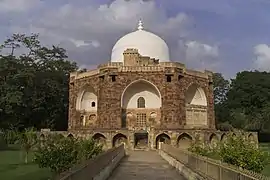
Indo-Islamic architecture style of Gujarat presages many of the architectural elements later found in Mughal architecture, including ornate mihrabs and minarets, jali (perforated screens carved in stone), and chattris (pavilions topped with cupolas).
Mughal architecture in Gujarat includes the Hazira Maqbara in Vadodara,[13] and Mughal Sarai in Surat.
British Colonial architecture (1858-1947 CE)
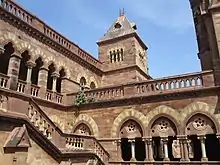
During the British colonial period, Gujarat was ruled by several princely states, the rulers of which designed elaborate palaces and public buildings. These were built in various Indo-European styles.
Gothic
Gothic buildings in Gujarat include the Prag Mahal designed by Henry Saint Clair Wilkins.
Indo-Saracenic
The Indo-Saracenic buildings in Gujarat includes the Vijaya Vilas Palace in Mandvi, Laxmi Vilas Palace and Nyay Mandir in Vadodara. The Maharaja Sayajirao University was designed by Robert Chisholm.
Rajmahal, a palace in Mehsana completed in 1904, is another example designed by the English architect Frederick William Stevens.[14][15][16]
Post-Independence (1947 CE - present)
Modernist
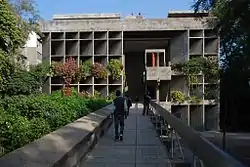
Le Corbusier, was invited to Ahmedabad in the 20th century by the mill owners to design their villas as well as some public buildings. The Sanskar Kendra, Villa Sarabhai, Villa Shodhan, and Mill Owners' Association Building in Ahmedabad were designed by Le Corbusier.[17]
American architect Louis Kahn designed the IIM Ahmedabad.[17]
The Premabhai Hall, Tagore Memorial Hall, and Institute of Indology in Ahmedabad were designed by B. V. Doshi, an architect who worked under both Corbusier and Louis Kahn.[18][19][20]
See also
References
- ↑ Dhaky, Madhusudan A. (1961). Deva, Krishna (ed.). "The Chronology of the Solanki Temples of Gujarat". Journal of the Madhya Pradesh Itihas Parishad. Bhopal: Madhya Pradesh Itihas Parishad. 3: 3–7, 10–12, 70–73.
- ↑ Nanavati, J. M.; Dhaky, M. A. (1969-01-01). "The Maitraka and the Saindhava Temples of Gujarat". Artibus Asiae. Supplementum. 26: 3–83. doi:10.2307/1522666. JSTOR 1522666.
- 1 2 Nanavati, J. M.; Dhaky, M. A. (1969-01-01). "The Maitraka and the Saindhava Temples of Gujarat". Artibus Asiae. Supplementum. 26: 3–83. doi:10.2307/1522666. JSTOR 1522666.
- ↑ Nanavati, J. M.; Dhaky, M. A. (1969-01-01). "The Maitraka and the Saindhava Temples of Gujarat". Artibus Asiae. Supplementum. 26: 3–83. doi:10.2307/1522666. JSTOR 1522666.
- ↑ "Rani-ki-Vav (the Queen's Stepwell) at Patan, Gujarat". UNESCO World Heritage Centre. Archived from the original on 2019-09-03. Retrieved 2019-09-26.
- ↑ LAMBOURN, ELIZABETH A. (2010). "A Self-Conscious Art? Seeing Micro-Architecture in Sultanate South Asia". Muqarnas. 27: 121–156. doi:10.1163/22118993_02701007. ISSN 0732-2992. JSTOR 25769695.
- ↑ "The Shaking Minarets at Ahmedabad, drawn in 1809", British Library
- ↑ Harle, 429-430
- ↑ Patel 2004, pp. 7–11.
- ↑ Patel 2004, pp. xi–xvi.
- ↑ "Historic City of Ahmadabad". UNESCO World Heritage Centre. Archived from the original on 2019-09-03. Retrieved 2019-09-26.
- ↑ "Champaner-Pavagadh". Worldheritagesite.org. Archived from the original on 6 October 2012. Retrieved 23 September 2012.
- ↑ Parikh, Vibhuti (2012). "The Hajira: A Symbol of Emerging Mughal Power in Gujarat". Proceedings of the Indian History Congress. 73: 255–260. ISSN 2249-1937. JSTOR 44156213.
- ↑ Sergeant, Philip W. (1928). The Ruler of Baroda: An Account of the Life and Work of the Maharaja Gaekwar. Albemarle Street, London: John Murray. pp. 226–229.
- ↑ Aklekar, Rajendra B. (2017-04-22). "A Sentimental Visit to Mumbai to See Her Great Grandfather's Magnificent Buildings". The Wire. Retrieved 2020-11-06.
court houses at Mehsana for the Gaekwads of Baroda.
- ↑ "Journal of the Indian Institute of Architects". Journal of the Indian Institute of Architects. The Indian Institute of Architects: 28. 2003. (Collection of Volume 68, Issue 1 - Volume 69, Issue 12)
- 1 2 Ajay, Lakshmi (2015-08-23). "Living in a cube: Corbusier designed some of Ahmedabad's most iconic buildings". The Indian Express. New Delhi. Archived from the original on 2019-09-30. Retrieved 2019-09-30.
- ↑ Bhatia, Gautam (2018-03-10). "An architecture for India: Balkrishna Doshi". The Hindu. ISSN 0971-751X. Retrieved 2019-10-01.
- ↑ Pogrebin, Robin (2018-03-07). "Top Architecture Prize Goes to Low-Cost Housing Pioneer From India". The New York Times. ISSN 0362-4331. Retrieved 2019-10-01.
- ↑ Atlas of Brutalist Architecture. Phaidon Press. 2018-10-17. ISBN 9780714875668.
Sources
- Patel, Alka (2004). Building Communities in Gujarāt: Architecture and Society During the Twelfth Through Fourteenth Centuries. BRILL. pp. xi–xvi, 3–20. ISBN 90-04-13890-0.
Further reading
- Vasavada, Rabindra; Jain, Tanvi; Tayyibji, Riyaz (1998). "Evolving scenario of Architecture in Gujarat: an overview". Seminar (India) Magazine.
